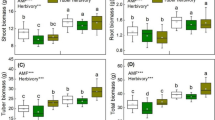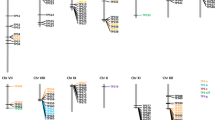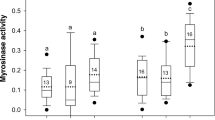Abstract
Plants mediate interactions between aboveground and belowground herbivores. Although effects of root herbivory on foliar herbivores have been documented in several plant species, interactions between tuber-feeding herbivores and foliar herbivores are rarely investigated. We report that localized tuber damage by Tecia solanivora (Guatemalan tuber moth) larvae reduced aboveground Spodoptera exigua (beet armyworm) and Spodoptera frugiperda (fall armyworm) performance on Solanum tuberosum (potato). Conversely, S. exigua leaf damage had no noticeable effect on belowground T. solanivora performance. Tuber infestation by T. solanivora induced systemic plant defenses and elevated resistance to aboveground herbivores. Lipoxygenase 3 (Lox3), which contributes to the synthesis of plant defense signaling molecules, had higher transcript abundance in T. solanivora-infested leaves and tubers than in equivalent control samples. Foliar expression of the hydroxycinnamoyl-CoA quinate hydroxycinnamoyl transferase (HQT) and 3-hydroxy-3-methylglutaryl CoA reductase I (HMGR1) genes, which are involved in chlorogenic acid and steroidal glycoalkaloid biosynthesis, respectively, also increased in response to tuber herbivory. Leaf metabolite profiling demonstrated the accumulation of unknown metabolites as well as the known potato defense compounds chlorogenic acid, α-solanine, and α-chaconine. When added to insect diet at concentrations similar to those found in potato leaves, chlorogenic acid, α-solanine, and α-chaconine all reduced S. exigua larval growth. Thus, despite the fact that tubers are a metabolic sink tissue, T. solanivora feeding elicits a systemic signal that induces aboveground resistance against S. exigua and S. frugiperda by increasing foliar abundance of defensive metabolites.






Similar content being viewed by others
References
Beninger CW et al (2004) A flavanone and two phenolic acids from Chrysanthemum morifolium with phytotoxic and insect growth regulating activity. J Chem Ecol 30:589–606
Bernays EA, Oppenheim S, Chapman RF, Kwon H, Gould F (2000) Taste sensitivity of insect herbivores to deterrents is greater in specialists than in generalists: a behavioral test of the hypothesis with two closely related caterpillars. J Chem Ecol 26:547–563
Bezemer TM, Van-Dam NM (2005) Linking aboveground and belowground interactions via induced plant defenses. Trends Ecol Evol 20:617–624
Bezemer TM, Wagenaar R, Van Dam NM, Wäckers FL (2003) Interactions between above- and belowground insect herbivores as mediated by the plant defense system. Oikos 101:555–562
Bradford MM (1976) A rapid and sensitive method for the quantitation of microgram quantities of protein utilizing the principle of protein-dye binding. Anal Biochem 72:248–254
Eichenseer H, Bi JL, Felton GW (1998) Indiscrimination of Manduca sexta larvae to overexpressed and underexpressed levels of phenylalanine ammonia-lyase in tobacco leaves. Ent Exp Appl 87:73–78
Erb M et al (2009) Signal signature of aboveground-induced resistance upon belowground herbivory in maize. Plant J 59:292–302
Felton GW, Donato KK, Broadway RM, Duffey SS (1991) Impact of oxidized plant phenolics on the nutritional quality of dietary protein to a noctuid herbivore, Spodoptera exigua. J Insect Physiol 38:277–285
Friedman M (2006) Potato glycoalkaloids and metabolites: roles in the plant and in the diet. J Agric Food Chem 54:8655–8681
Gange AC, Brown VK (1989) Effects of root herbivory by an insect on a foliar-feeding species, mediated through changes in the host plant. Oecologia 81:38–42
Ginzberg I et al (2012) Induction of potato steroidal glycoalkaloid biosynthetic pathway by overexpression of cDNA encoding primary metabolism HMG-CoA reductase and squalene synthase. Planta 235:1341–1353
Green TR, Ryan CA (1972) Wound-induced proteinase inhibitor in plant leaves—possible defense mechanism against insects. Science 175:776–777
Hanounik SB, Osborne WW (1977) The relationships between population density of Meloidogyne incognita and nicotine content of tobacco. Nematologica 23:147–152
Huang W, Siemann E, Xiao L, Yang XF, Ding JQ (2014) Species-specific defence responses facilitate conspecifics and inhibit heterospecifics in above-belowground herbivore interactions. Nat Comm. doi:10.1038/Ncomms5851
Johnson KS, Felton GW (2001) Plant phenolics as dietary antioxidants for herbivorous insects: a test with genetically modified tobacco. J Chem Ecol 27:2579–2597
Johnson SN, Hawes C, Karley AJ (2009) Reappraising the role of plant nutrients as mediators of interactions between root- and foliar-feeding insects. Funct Ecol 23:699–706
Johnson SN, Clark KE, Hartley SE, Jones TH, McKenzie SW, Koricheva J (2012) Aboveground-belowground herbivore interactions: a meta-analysis. Ecology 93:2208–2215
Jongsma MA, Bakker PL, Visser B, Stiekema WJ (1994) Trypsin inhibitor activity in mature tobacco and tomato plants is mainly induced locally in response to insect attack, wounding and virus infection. Planta 195:29–35
Kolomiets MV, Chen H, Gladon RJ, Braun EJ, Hannapel DJ (2000) A leaf lipoxygenase of potato induced specifically by pathogen infection. Plant Physiol 124:1121–1130
Kumar GN, Iyer S, Knowles NR (2007) Extraction of RNA from fresh, frozen, and lyophilized tuber and root tissues. J Agric Food Chem 55:1674–1678
Lachman J, Hamouz K, Orsák M, Pivec V (2001) Potato glycoalkaloids and their significance in plant protection and human nutrition. Rostlinná Výroba 47:181–191
Masters GJ, Jones TH, Rogers M (2001) Host-plant mediated effects of root herbivory on insect seed predators and their parasitoids. Oecologia 127:246–250
Nandi B, Kundu KBN, Babu SPS (2003) Salicylic acid-induced suppression of Meloidogyne incognita infestation of okra and cowpea. Nematology 5:747–752
Niño L (2004) Revision sobre la polilla de la papa Tecia solanivora en Centro y Suramerica. Suplemento Revista Latinoamericana de la Papa 199:200
Omer AD, Thaler JS, Granett J, Karban R (2000) Jasmonic acid induced resistance in grapevines to a root and leaf feeder. J Econ Entomol 93:840–845
Pariera Dinkins CL, Peterson RK, Gibson JE, Hu Q, Weaver DK (2008) Glycoalkaloid responses of potato to Colorado potato beetle defoliation. Food Chem Toxicol 46:2832–2836
Payyavula RS, Shakya R, Sengoda VG, Munyaneza JE, Swamy P, Navarre DA (2015) Synthesis and regulation of chlorogenic acid in potato: rerouting phenylpropanoid flux in HQT-silenced lines. Plant Biotechnol J 13:551–564
Pierre SP, Dugravot S, Herve MR, Hassan HM, van Dam NM, Cortesero AM (2013) Belowground induction by Delia radicum or phytohormones affect aboveground herbivore communities on field-grown broccoli. Front Plant Sci 4:305. doi:10.3389/fpls.2013.00305:305
Poveda K, Gómez MI, Kessler A (2010) The enemy as ally: herbivore-induced increase in crop yield. Ecol Appl 20:1787–1793
Poveda K, Jimenez MIG, Halitschke R, Kessler A (2012) Overcompensating plants: their expression of resistance traits and effects on herbivore preference and performance. Ent Exp Appl 143:245–253
Rasmann S, Turlings TC (2007) Simultaneous feeding by aboveground and belowground herbivores attenuates plant-mediated attraction of their respective natural enemies. Ecol Lett 10:926–936
Rodriguez-Falcon M, Bou J, Prat S (2006) Seasonal control of tuberization in potato: conserved elements with the flowering response. Annu Rev Plant Biol 57:151–180
Royo J et al (1996) Characterization of three potato lipoxygenases with distinct enzymatic activities and different organ-specific and wound-regulated expression patterns. J Biol Chem 271:21012–21019
Royo J et al (1999) Antisense-mediated depletion of a potato lipoxygenase reduces wound induction of proteinase inhibitors and increases weight gain of insect pests. Proc Natl Acad Sci USA 96:1146–1151
Salazar J, Escalante W (1984) La polilla guatemalteca de la papa, Scrobipalpopsis solanivora, nueva plaga del cultivo de la papa en Venezuela. J Agronom 9:24–28
Sarkar D (2008) The signal transduction pathways controlling in planta tuberization in potato: an emerging synthesis. Plant Cell Rep 27:1–8
Soler R, Erb M, Kaplan I (2013) Long distance root-shoot signalling in plant-insect community interactions. Trends Plant Sci 18:149–156
Tamhane VA, Giri AP, Kumar P, Gupta VS (2009) Spatial and temporal expression patterns of diverse Pin-II proteinase inhibitor genes in Capsicum annuum Linn. Gene 442:88–98
van Dam NM, Raaijmakers CE (2006) Local and systemic induced responses to cabbage root fly larvae (Delia radicum) in Brassica nigra and B. oleracea. Chemoecology 16:17–24
van Dam NM, Raaijmakers CE, van der Putten WH (2005) Root herbivory reduces growth and survival of the shoot feeding specialist Pieris rapae on Brassica nigra. Ent Exp Appl 115:161–170
Wardle DA, Bardgett RD, Klironomos JN, Setala H, van der Putten WH, Wall DH (2004) Ecological linkages between aboveground and belowground biota. Science 304:1629–1633
Xia J, Psychogios N, Young N, Wishart DS (2009) MetaboAnalyst: a web server for metabolomic data analysis and interpretation. Nucleic Acids Res 37:652–660
Xu X, van Lammeren AA, Vermeer E, Vreugdenhil D (1998) The role of gibberellin, abscisic acid, and sucrose in the regulation of potato tuber formation in vitro. Plant Physiol 117:575–584
Acknowledgments
This research was funded by United States Department of Agriculture—National Institute of Food and Agriculture award number 2014-67013-21659 to GJ and KP. We thank Meena Haribal and Melkamu G. Woldemariam for assistance with the metabolomics assays, and the Triad Foundation for making possible the purchase of a Thermo Q-Exactive mass spectrometer.
Author contribution statement
PK, EGG, EVO, KP, and GJ conceived and designed the experiments. PK, EVO, and EGG conducted the experiments. PK analyzed the data. PK, GJ, KP, EGG, and EVO wrote the manuscript.
Author information
Authors and Affiliations
Corresponding author
Additional information
Communicated by Colin Mark Orians.
Electronic supplementary material
Below is the link to the electronic supplementary material.
Rights and permissions
About this article
Cite this article
Kumar, P., Ortiz, E.V., Garrido, E. et al. Potato tuber herbivory increases resistance to aboveground lepidopteran herbivores. Oecologia 182, 177–187 (2016). https://doi.org/10.1007/s00442-016-3633-2
Received:
Accepted:
Published:
Issue Date:
DOI: https://doi.org/10.1007/s00442-016-3633-2




